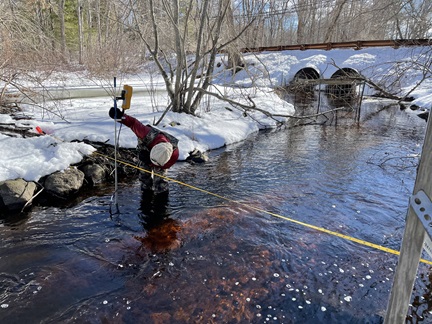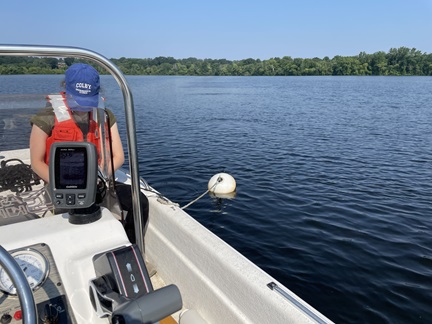Routine Sampling
Under baseflow (dry-weather) conditions, Watershed Division staff collect water samples, measure streamflow, and monitor in situ parameters (dissolved oxygen, specific conductance, temperature, chlorophyll-a, and pH) throughout the watershed. Baseflow sampling, conducted in regular intervals on days with no more than 0.10 in of rain 72 hours prior, provides a representative water quality measurement without the influence of stormwater. Routine baseflow sampling is conducted 6 to 8 times a year at 9 reservoir and 12 tributary monitoring stations. The Watershed Division also collects weekly samples from the intake structures of Hobbs Brook Reservoir and Stony Brook Reservoir under all weather conditions. Routine samples from the Fresh Pond Reservoir intake are performed separately by water treatment staff at the Walter J. Sullivan Water Treatment Facility.

Reservoirs
The Hobbs Brook, Stony Brook, and Fresh Pond Reservoirs are all sampled using United States Geological Survey (USGS) clean-sampling protocols. Routine baseflow sampling of each reservoir includes surface grab samples from the deepest location in each reservoir and select other monitoring locations. During summer months, when the water column is thermally stratified, additional water quality samples are pumped from below the thermocline (the point of maximum rate of change in water temperature with depth) at the deepest point of the reservoirs with a peristaltic pump through pre-cleaned Tygon tubing. For all reservoir sites sampled by boat, Watershed Division staff collect snapshots of in situ parameters using a water quality probe every meter in depth. This allows Watershed Division staff to profile water chemistry throughout the water column. Staff also perform Secchi disk readings to assess water column transparency. At shoreline reservoir monitoring stations, Watershed Division staff collect samples and in situ snapshots only at the water surface.

Samples are analyzed at the Cambridge Water Department laboratory for total organic carbon, color, alkalinity, nitrates/nitrites, turbidity, bacteria, pH, concentrations of major ions (sodium, calcium, chloride, and sulfate), specific conductivity, and selected metals (aluminum, iron, and manganese) using standard methods. Select nutrients (ammonia nitrogen, total Kjeldahl nitrogen, and total phosphorus) and chlorophyll-a are analyzed at contracted laboratories.
Weekly samples collected from the Hobbs Brook and Stony Brook Reservoir intakes are comprised of surface grab samples only. These samples are not analyzed for chlorophyll-a or nutrients.
The Watershed Division also regularly monitors algae in the reservoirs through the Algae Monitoring Program.
Tributaries
Water entering the reservoirs is sampled at 12 tributary monitoring stations 6 to 8 times a year during baseflow conditions. Specific conductance, pH, water temperature, and dissolved oxygen concentrations are measured in situ with a water quality probe and water samples are collected at the stream channel center in accordance with clean-sampling protocols. The samples are analyzed at both the Cambridge Water Department laboratory and contracted laboratories for the same suite of parameters as the reservoir baseflow samples except for chlorophyll-a.
Additionally, Watershed Division staff measure biological indicators of stream health through the Benthic Macroinvertebrate Indicator Monitoring Program.
